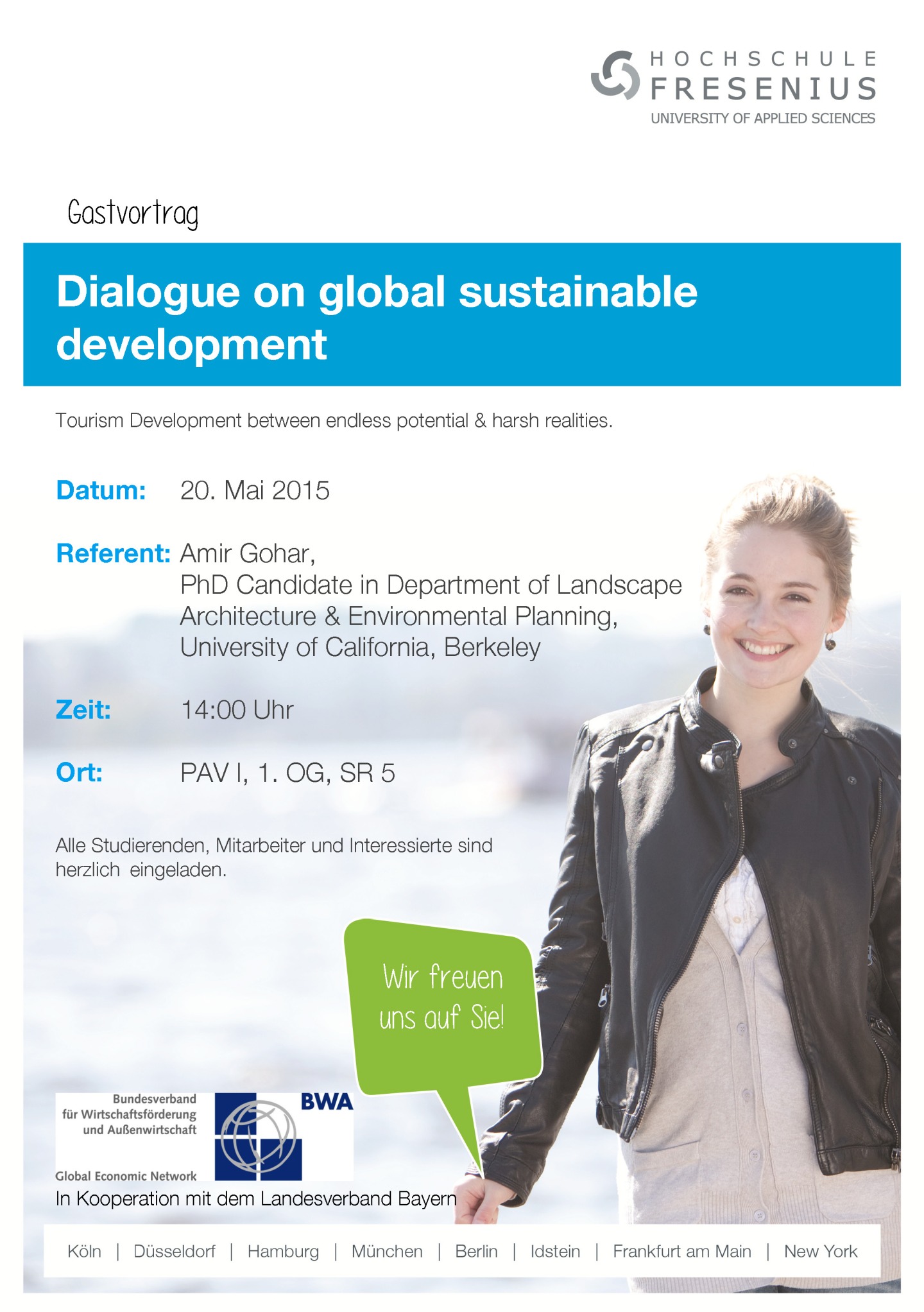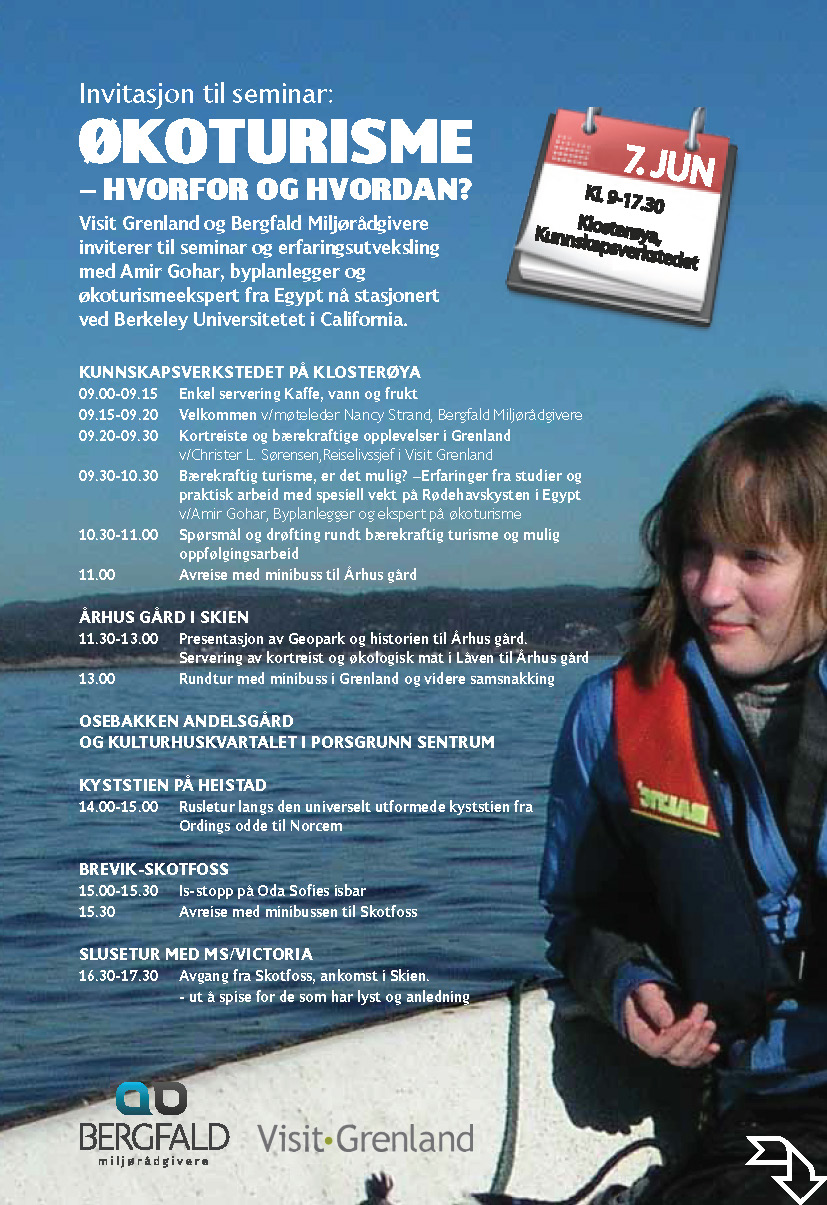Interview in College of environmental Design, UC Berkeley
Q: You lived between Egypt, Qatar, and other countries in your youth. How did your upbringing influence your current interest in ecotourism?
Growing up in Qatar, we lived in a very small neighborhood among a global community of expats. The diversity of the surrounding community exposed me to a variety of of cultures, religions, and backgrounds. I was very fortunate that my parents were well educated and progressive, and believed in investing in my education.
Family summer vacations in different countries gave me an appreciation for a wide range of natural environments and local cultures. Visiting Bedouins in tent encampments, I witnessed their environmental best practices which initiated my understanding of how an ecosystem functions. My experience as a Boy Scout further shaped and added discipline to my relationship with nature.
Q: So environmental planning for tourism developments is a natural fit for you.
Yes, it combines my personal interest as an ecotourist with my interest in protecting nature for future generations. I started to observe, in my undergraduate studies and in my early professional career, the destructive nature of mass tourism — its negative impacts on local environments and local cultures. As a land use planner, I was interested in how we could design these types of tourism establishments so that they are in harmony with nature, rather than in conflict with flood plains or other ecosystems.
In my later work in the Red Sea mountain range and eastern Libya, in local oases with indigenous communities, I was part of a concerted effort to protect both the architecture and the oases.

TRADERS AND LOCAL SHAVING SERVICES DURING THE PEAK FESTIVAL, EL-SHEIKH EL-SHAZLI VILLAGE. PHOTO: AMIR GOHAR
Q: What is your educational background?
I received my Bachelors degree in Urban Planning from the Faculty of Urban & Regional Planning, Cairo University; my Masters in Urban Design from the Joint Center of Urban Design, Oxford Brookes University; and a Diploma in Land Management from the Institute of Housing & Urban Development Studies (HIS), Erasmus University. At Cairo University I gained my first exposure to landscape planning and design, and design for tourism facilities in particular. My Masters work built on that, focusing on design that connected cities, culminating in an urban tourism revitalization project in the city of Guayaquil, Ecuador.
Q: For over a decade after you completed your Masters, until you began your PhD at Berkeley, you worked on many urban planning and land use projects mainly in the Red Sea region. Can you describe a couple of those projects and how they shaped your approach?
In 2005, working with USAID, I headed a planning unit to implement an integrated community development plan in El-Sheikh El-Shazli Village — a remote pilgrimage site in the Red Sea mountain range. The multi-year project included an overall master plan for the entire village, urban design of a visitor camping constellation and plaza in the main shrine, and the design and construction of specific facilities. All these phases included very comprehensive environmental analyses and social impact assessments, as well as working with the local people.
Shortly after, I led the planning unit of the al-Darb al-Ahmar Revitalization Project, working closely with the Agha Khan Trust for Culture (AKTC) to develop a road network plan in historic Cairo to match the local building principles in New Cairo.
The tourism component of the Cairo project was within the built form of an urban center, unlike El-Shazli where we were developing an ecotourism site in a very remote area. These two projects represent the two sides of my passion and research — cultural sites in dense historic urban areas and in nomadic wilderness areas. The majority of my work has centered around tourism, nature, and engaging the local culture.

TRAFFIC AND ACCESSIBILITY PLAN FOR CAIRO

NOMADIC STRUCTURE IN THE RED SEA DESERT. PHOTO: AMIR GOHAR
Q: You have been affiliated with a number of urban development NGOs in Egypt. Describe some of this work.
I have held a variety of positions in several non-profits. The common thread in all of these is ensuring that the built environment works in harmony with nature. Examples are Midan, a non-profit I co-founded focusing on urban public space, and EECA where I advised on a residential expansion of the Al-Jaghboub Oasis in eastern Libya. Here there was an attempt by the Libyan government, prior to the Arab Spring, to create stronger bonds with the tribes in marginalized areas. We provided planning and guidance to design a housing development in an environmentally and culturally sound way, including engaging women in the process.
Q: Please describe your thesis project, ENVIRONMENTAL AND CULTURAL TRADEOFFS OF ECOTOURISM IN EGYPT
I am trying to measure the relative impact of ecotourism as compared to mass tourism. As an escape from mass tourism, we assume that ecotourist destinations are more sustainable, but we are still leaving a footprint that may be less apparent, yet significant.
I am focusing on 33 resorts in and around the southern Red Sea region of Egypt where there is also considerable coastal development. I am comparing six resorts which claim to be eco-friendly to the other 27 to see if their claim is real — are they truly a more ecologically sound solution?
Ultimately, I’m trying to find the optimum solution — to create better tourism resorts and prevent developments in places that cannot sustain them. I’m also hoping to provide recommendations to inform policy makers on how to improve the environment assessment process.

LOCAL TRIBESMAN IN THE RED SEA DESERT. PHOTO: AMIR GOHAR
Q: What are the most interesting aspects of your research?
When we design for ecotourism in Egypt, and in many parts of the world, we — by that I mean practitioners, scholars, academics, and policy makers — typically focus on the product, the architecture, without assessing the overall process that led to that product. So for example, we might end up with a massive concrete development on a salt marsh that is killing the mangroves, impacting the flood plain, and disrupting turtle nesting sites. When we try to lessen the impact in a subsequent project, we still use the same design process rather than looking deeper to assess whether that region is even capable of sustaining a tourist resort.
There are also cultural and social components of ecotourism that are not easily seen by designers. So, for instance, building a resort in a bay can impact the livelihood of local tribes by limiting their access to traditional fishing areas without physical displacement of the people themselves. Or coastal resorts may require drilling wells, reducing the water table and affecting tribes settling around specific wells upstream in the highlands. So the interaction between tourism on the Red Sea coast and tribes’ livelihood, trail systems, and natural habitat can constitute a bigger conflict than it appears.

AL-JAGHBOUB OASIS, LIBYA. PHOTO: AMIR GOHAR
Q: What are your goals once you have completed your PhD?
Once I complete my PhD, ideally by the end of the spring semester 2016, I hope to obtain a teaching position where I can carry on making the world a better place. In my experience working in Egypt, while I was able to make significant contributions culturally and environmentally through pilot projects and initiatives, those advancements were eroded because of the existing systems in the government.
The 2011 Egyptian revolution gave me hope and showed me the importance of the work I had been doing. It also educated me that change is not going happen from the bottom up. It is not enough to set examples of good practices via pilot projects —there has to be political will to protect the local environment and local culture.
I became involved in academia because I realized the importance of education in spreading knowledge about environmental and cultural protection. I started to see academia as an expansion of my revolution. To be a professor who can inspire people to care about the environment and society is a genuine passion that drives my research and academic career.



